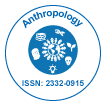
Anthropology
Open Access
ISSN: 2332-0915

ISSN: 2332-0915
Opinion Article - (2024)Volume 12, Issue 4
Physical anthropology, also known as biological anthropology, is a branch of anthropology that studies humans as biological beings within the framework of evolution. It examines the biological and physical aspects of human beings, their ancestors and their closest relatives, including primates. This field combines biology, paleontology, anatomy, genetics and archaeology to understand human origins, diversity and adaptations over time. By investigating the biological basis of human life and its interactions with the environment, physical anthropology seeks to uncover the story of our species and its place in the natural world.
A central focus of physical anthropology is the study of human evolution. Physical anthropologists examine the fossil record to trace the development of early hominins and understand how environmental pressures changed their physical and behavioral adaptations. Fossils of species such as Australopithecus, Homo habilis and Homo erectus provide important analysis into the evolutionary processes that led to modern humans (Homo sapiens). These findings help anthropologists understand traits such as bipedalism, brain size, tool use and dietary adaptations, all of which are key to human survival and development.
Primatology, another important subfield, involves the study of non-human primates like monkeys, apes and lemurs. By observing the behavior, social structures and ecology of primates, researchers can draw parallels to early human behavior and gain analysis into the evolutionary roots of traits such as social organization, communication and parenting. Primatology also contributes to conservation efforts, as many primate species face threats from habitat destruction and climate change.
Physical anthropologists also study human biological diversity, focusing on how populations vary in traits such as skin color, height and genetic markers. These variations are shaped by factors like genetic inheritance, environmental influences and cultural practices. For instance, the distribution of skin pigmentation across the globe is linked to the intensity of ultraviolet radiation and its effects on vitamin D synthesis and folate protection. Understanding such variations helps anthropologists address misconceptions about race, emphasizing that race is a social construct rather than a biological determinant.
In addition to studying the past and present, physical anthropologists also investigate how humans interact with their environments and adapt to changing conditions. This area, known as bioarcheology, examines human remains to understand health, diet and lifestyle in ancient populations. For example, the analysis of bones and teeth can reveal information about malnutrition, disease and physical labor in historical societies. By understanding these aspects, physical anthropologists provide a broader picture of how human populations have adapted to diverse environments over millennia.
Another important area of physical anthropology is forensic anthropology, which applies biological anthropology to legal contexts. Forensic anthropologists analyze human skeletal remains to determine age, sex, ancestry and cause of death, assisting in criminal investigations and identifying unknown individuals. Their expertise is important in cases of mass disasters, war crimes and missing persons.
Genetics also plays a significant role in physical anthropology, as researchers analysis how genetic inheritance influences human traits and how populations have migrated and mixed over time. Advances in DNA technology allow physical anthropologists to study ancient DNA from fossils, shedding light on the genetic relationships between early humans, Neanderthals and other hominins. Such study has revealed surprising awareness, such as evidence of interbreeding between modern humans and Neanderthals, which has left traces in the genomes of contemporary populations.
The interaction between biology and culture is another area of interest in physical anthropology. While it focuses on biological factors, this field acknowledges the influence of culture on human biology. For example, cultural practices such as diet, physical activity and healthcare significantly impact health and longevity, illustrating the complex relationship between biology and society.
In conclusion, physical anthropology is a multidisciplinary field that bridges biology and anthropology to examine the biological and evolutionary aspects of humans. By studying fossils, genetics, primates and modern human populations, physical anthropologists contribute to our understanding of human origins, adaptations and diversity. This field not only uncovers the biological basis of human life but also emphasizes the interconnectedness of biological and cultural factors in changing the human experience. Through its diverse approaches, physical anthropology provides significant analysis into what it means to be human, both in the past and in the present.
Citation: Chenew D (2024). The Interaction between Biology and Culture in Physical Anthropology. Anthropology. 12:250.
Received: 29-Nov-2024, Manuscript No. ANTP-24-36689; Editor assigned: 02-Dec-2024, Pre QC No. ANTP-24-36689 (PQ); Reviewed: 16-Dec-2024, QC No. ANTP-24-36689; Revised: 23-Dec-2024, Manuscript No. ANTP-24-36689 (R); Published: 30-Dec-2024 , DOI: 10.35248/2332-0915.24.12.250
Copyright: © 2024 Chenew D. This is an open-access article distributed under the terms of the Creative Commons Attribution License, which permits unrestricted use, distribution and reproduction in any medium, provided the original author and source are credited.